|
| rainforests.mongabay.com/kids | |
WHAT ARE RAINFORESTS?
Tropical rainforests are forests with tall trees, warm climate, and lots of rain. In some rainforests it rains more than one inch every day!Rainforests are found in Africa, Asia, Australia, and Central and South America. The largest rainforest in the world is the Amazon rainforest.
WHERE ARE RAINFORESTS LOCATED?
Rainforests are found in the tropics, the region between the Tropic of Capricorn and Tropic of Cancer. In this region the sun is very strong and shines about the same amount of time every day all year long making the climate warm and stable.
- Brazil
- Congo (Democratic Republic)
- Peru
- Indonesia
- Colombia
- Papua New Guinea
- Venezeula
- Bolivia
- Mexico
- Suriname
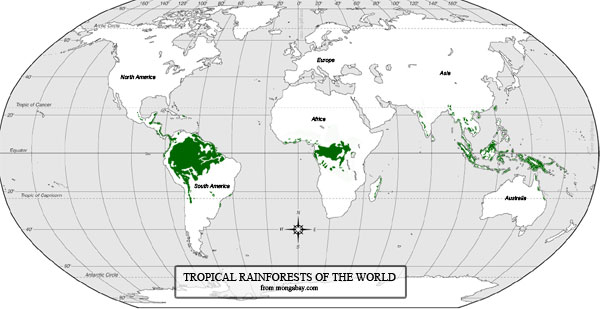
|
Each rainforest is unique but there are certain features common to all tropical rainforests.
- Location: rainforests lie in the �tropics�
- Rainfall: rainforests receive at least 80 inches of rain per year
- Canopy: rainforests have a canopy which is the layer of branches and leaves formed by closely spaced rainforest trees. Most of the plants and animals in the rainforest live in the canopy. The canopy may be 100 feet above the ground.
- Biodiversity: rainforests have a high level of biological diversity or biodiversity. Biodiversity is the name for all living things�like plants, animals, and fungi� found in an ecosystem. Scientists believe that about half of the plants and animals found on earth�s land surface live in rainforests.
- Symbiotic relationships between species: species in the rainforest often work together. A symbiotic relationship is a relationship where two different species benefit by helping each other. For example, some plants produce small housing structures and sugar for ants. In return the ants protect the plants from other insects that may want to feed on the plant�s leaves.
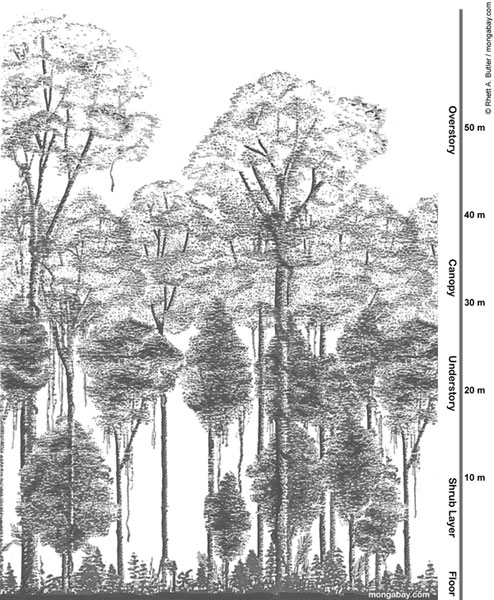
|
The environment of the canopy is very different from the environment of the forest floor. During the day, the canopy is drier and hotter than other parts of the forest, and the plants and animals that live there are specially adapted for life in the trees. For example, because the amount of leaves in the canopy can make it difficult to see more than a few feet, many canopy animals rely on loud calls or lyrical songs for communication. Gaps between trees mean that some canopy animals fly, glide, or jump to move about in the treetops.
Scientists have long been interested in studying the canopy, but because of the height of rainforest trees research has been difficult until recently. Today there are special facilities with rope bridges, ladders, and towers to help scientists discover the secrets of the canopy.
The canopy is just one of several vertical layers in the rainforest. Take a look at the diagram on the left to see the other layers (the overstory, understory, shrub layer, and forest floor).
THE RAINFOREST FLOOR
The leaves of the canopy often make the ground layer of the rainforest a dark and humid place. However, despite its constant shade, the rainforest floor is an important part of the forest ecosystem.
The forest floor is where decomposition takes place. Decomposition is the process by which decomposers like fungi and microorganisms break down dead plants and animals and recycle essential materials and nutrients.
Many of the largest rainforest animals are found on the forest floor. Some of these include elephants, tapirs, and jaguars.
WHY DO RAINFORESTS HAVE SO MANY KINDS OF PLANTS AND ANIMALS?
Tropical rainforests support the greatest diversity of living organisms on Earth. Although they cover less than 2 percent of Earth�s surface, rainforests house more than 50 percent of its plants and animals. Here are some examples of the richness of rainforests:
- rainforests have 170,000 of the world's 250,000 known plant species
- the United States has 81 species of frogs, while Madagascar which is smaller than Texas, may have 300 species.
- Europe has 321 butterfly species, while a park in the rainforest of Peru (Manu National Park) has 1300 species.
- Climate: because rainforests are located in tropical regions, they receive a lot of sunlight. This sunlight is converted to energy by plants through the process of photosynthesis. Since there is a lot of sunlight, that means there is a lot of energy in the rainforest. This energy is stored in plant vegetation which is eaten by animals. Because there is a lot of food there are many species of plants and animals.
- Canopy: the canopy structure of the rainforest means there are more places for plants to grow and animals to live. The canopy offers new sources of food, shelter, and hiding places, and provides another world for interaction between different species. For example there are plants in the canopy called bromeliads that store water in their leaves. Animals like frogs use these pockets of water for hunting and laying their eggs.
 Jaguar  Blue and yellow macaw  Chameleon (lizard) |
Orangutan  Silverback (adult male) Gorilla  Poison arrow frog |
 Caterpillar Green tree python  Monkey frog |
More pictures at travel.mongabay.com
RAINFOREST PEOPLE
Tropical rainforests are home to tribal people who rely on their surroundings for food, shelter, and medicines. Today very few forest people live in traditional ways; most have been displaced by outside settlers or have been forced to give up their lifestyles by governments.Of the remaining forest people, the Amazon supports the largest populations, though these people too, have been impacted by the modern world. While they still use the forest for traditional hunting and gathering, most Amerindians, as these people are called, grow crops (like bananas, manioc, and rice), use western goods (like metal pots, pans, and utensils), and make regular trips to towns and cities to bring foods and wares to market. Still, these forest people can teach us a lot about the rainforest. Their knowledge of medicinal plants used for treating illness is unmatched and they have a great understanding of the ecology of the Amazon rainforest.
In Africa there are native forest dwellers sometimes known as pygmies. The tallest of these people, also known as the Mbuti, rarely exceed five feet in height. Their small size enables them to move about the forest more efficiently than taller people.
GREAT CIVILIZATIONS IN THE RAINFOREST
Today most forest dwellers live in small settlements or practice nomadic hunting and gathering. In the past, tropical rainforests and surrounding areas supported great civilizations like the Mayas, Incas, and Aztecs, who developed complex societies and made great contributions to science.
These great civilizations faced some of the same environmental problems (excessive forest loss, soil erosion, overpopulation, lack of water supplies) that we face today. For the Maya, the damage to the environment may have been so great as to cause their downfall.
MEDICINAL PLANT KNOWLEDGE OF NATIVE PEOPLE

|
To date many of the prescription drugs used in the western world have been derived from plants and 70 percent of the plants identified as having anti-cancer characteristics by the U.S. National Cancer Institute are found only in the tropical rainforest.
Typically, knowledge of medicinal plants is carried by the shaman or �medicine man� of a village. The shaman treats the sick often during elaborate ceremonies and rituals using plants gathered from the surrounding forest.
WHAT HAPPENED TO THE NATIVE PEOPLE OF THE AMAZON?
Before the discovery of the New World by Christopher Columbus in the 15th century, an estimated 7-10 million Amerindians (the term for American indigenous peoples) lived in American rainforests, half of them in Brazil. Great cities existed in the Andes and the Amazon supported agricultural societies.
The arrival of Europeans brought the end of the native civilizations in Central and South America. Europeans carried diseases that killed millions of Amerindians, and within 100 years of the arrival of these outsiders, Amerindian population was reduced by 90 percent. Most of the surviving native people lived in the interior of the forest, either pushed there by the Europeans, or traditionally living there in smaller groups.
KIDS IN THE RAINFOREST
While they don�t watch TV, use the internet, or play video games, kids in the rainforest do many of the same things you probably do. They play with friends, help their families with chores, and go to school.
Since �rainforest kids� live closer to nature than the average American child, they learn things that are helpful in the environment around them. From an early age many children learn how to fish, hunt, and collect materials and food from the forest. Instead of going to a playground or a shopping mall for fun, children in places like the Amazon spend most of their time outdoors playing in the forest and in rivers and streams.
WHY ARE RAINFORESTS IMPORTANT?
Rainforests are important to the global ecosystem. Rainforests:- provide a home to many plants and animals;
- help stabilize the world's climate;
- protect against flood, drought, and erosion;
- are a source for medicines and foods;
- support tribal people; and
- are an interesting place to visit
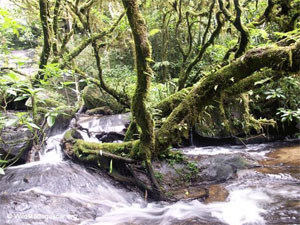 Rainforest in Madagascar |
Rainforests help stabilize the world�s climate by absorbing carbon dioxide from the atmosphere. Excess carbon dioxide in the atmosphere is believed to contribute to climate change through global warming. Therefore rainforests have an important role in addressing global warming.
Rainforests also affect local weather conditions by creating rainfall and moderating temperatures.
RAINFORESTS PROVIDE A HOME FOR PLANTS AND WILDLIFE
Rainforests are home to a large number of the world�s plant and animals species, including many endangered species. As forests are cut down, many species are doomed to extinction. Some rainforest species can only survive in their natural habitat. Zoos cannot save all animals.
RAINFORESTS HELP MAINTAIN THE WATER CYCLE
Rainforests help maintain the water cycle. According to the U.S. Geological Survey, �the water cycle, also known as the hydrologic cycle, describes the continuous movement of water on, above, and below the surface of the Earth.�
The role of rainforests in the water cycle is to add water to the atmosphere through the process of transpiration (where they release water from their leaves during photosynthesis). This moisture contributes to the formation of rain clouds which release the water back on the rainforest. In the Amazon, 50-80 percent of moisture remains in the ecosystem�s water cycle.
When the forests are cut down, less moisture is goes into the atmosphere and rainfall declines, and this decline sometimes leads to drought.
RAINFORESTS REDUCE EROSION
The roots of rainforest trees and vegetation help anchor the soil. When trees are cut down there is no longer anything to protect the ground, and soils are quickly washed away with rain. The process of washing away of soil is known as erosion.
As soil is washed down into rivers, it causes problems for fish and people. Fish suffer because water becomes clouded, while people have trouble navigating waterways that are shallower because of the increased amount of dirt in the water. Meanwhile farmers lose topsoil that is important for growing crops.
WHY ARE RAINFORESTS BEING DESTROYED?
Every year an area of rainforest the size of New Jersey is cut down and destroyed. The plants and animals that used to live in these forests either die or must find a new forest to call their home. Why are rainforests being destroyed?Humans are the main cause of rainforest destruction or deforestation. Humans are cutting down rainforests for many reasons, including:
- wood for both timber and wood for making fires;
- agriculture for both small and large farms;
- land for poor farmers who don't have anywhere else to live;
- grazing land for cattle; and
- road construction
One of the leading causes of rainforest destruction is logging. Many types of wood used for furniture, flooring, and construction are harvested from tropical forests in Africa, Asia, and South America. By buying certain wood products, people in places like the United States are directly contributing to the destruction of rainforests.
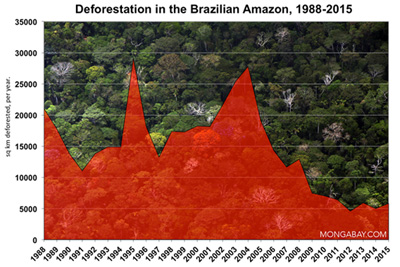
|
Research has found that the number of species found in logged rainforest is much lower than the number found in untouched primary rainforest. Many rainforest animals cannot survive in the changed environment.
Local people often rely on harvesting wood for rainforests for fire wood and building materials. In the past such practices were not particularly damaging to the ecosystem. However, today in areas with large human populations, the sheer number of people collecting wood from an area rainforest can be extremely damaging. For example the forests around the refugee camps in Central Africa (Rwanda and Congo) were virtually stripped of all trees in some areas.
AGRICULTURE IN THE RAINFOREST
Every year thousands of miles of rainforest are destroyed for agricultural use. The two main groups responsible for converting rainforest into farmland are poor farmers and corporations,
Poor farmers in many parts of the world rely on clearing rainforest to feed their families. Without access to better agricultural lands, these people use slash-and-burn to clear patches of forest for short-term periods. Typically, they farm the cleared land for a couple of years before the soil is exhausted of nutrients and they must move on to a new patch of forest.
Agricultural companies are clearing more rainforest than ever before, especially in the Amazon where large tracts of rainforest are being converted into soybean farms. Some experts believe that South America will someday have an area of farmland that rivals that of the American Midwest. Much of this farmland will come at the expense of the Amazon rainforest.
CATTLE IN THE RAINFOREST
Clearing for cattle pasture is the leading cause of deforestation in the Amazon, and Brazil now produces more beef than ever before. Besides raising cattle for food, many landowners use cattle to expand their land holdings. By simply placing cattle on an area of forest land, landowners can gain ownership rights to that land.
ROAD CONSTRUCTION IN THE RAINFOREST
Road and highway construction in the rainforest opens up large areas for development. In Brazil, the Trans-Amazonian highway resulted in the destruction of huge areas of forest by poor colonists, loggers, and land speculators. In Africa, logging roads give access to poachers who hunt endangered wildlife as �bushmeat� or as meat sold to city dwellers.
THE ROLE OF POVERTY IN DEFORESTATION
Poverty plays a major role in deforestation. The world�s rainforests are found in the poorest areas on the planet. The people who live in and around rainforests rely on these ecosystems for their survival. They collect fruit and wood, hunt wildlife to put meat on the table, and are paid by companies that extract resources from forest lands.
Most rural poor never have the options that we in western countries take for granted. These people almost never have a choice to go to college or become doctors, factory workers, or secretaries. They must live off the land that surrounds them and make use of whatever resources they can find. Their poverty costs the entire world through the loss of the tropical rainforests and wildlife. Without providing for these people, rainforests cannot be saved.
HOW CAN WE SAVE RAINFORESTS?
Rainforests are disappearing very quickly. The good news is that there are a lot of people who want to save rainforests. The bad news is that saving rainforests is not going to be easy. It will take the efforts of many people working together in order to ensure that rainforests and their wildlife will survive for your children to appreciate and enjoy.Some steps for saving rainforests and, on a broader scale, ecosystems around the world involve focusing on �TREES�:
- Teach others about the importance of the environment and how they can help save rainforests.
- Restore damaged ecosystems by planting trees on land where forests have been cut down.
- Encourage people to live in a way that doesn't hurt the environment
- Establish parks to protect rainforests and wildlife
- Support companies that operate in ways that minimize damage to the environment
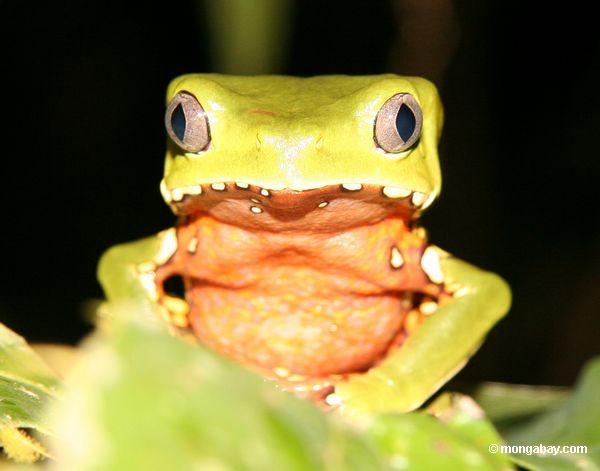
|
In the United States, people need to understand their role in the loss of rainforests. For example, buying certain products like mahogany contributes to the cutting down of rainforests in other countries. If we as Americans make an effort to learn about the environment we can understand what we�re losing as rainforest disappears. We can also make decisions to buy products and support companies and organizations that help the rainforest.
In rainforest countries local people sometimes do not know why forests are important. Through educational programs these people can learn that forests provide key services (like clean water) and are home to plants and animals found nowhere else in the world. Few children in a place like Madagascar know that lemurs are not found in America. They are quite happy when they learn that lemurs only live in Madagascar.
REHABILITATE AND RESTORE RAINFORESTS
In trying to protect rainforests we need to also look at how damaged forests can be brought back to health. While it is impossible to replant a rainforest, some rainforests can recover after they have been cut down�especially if they have some help through the planting of trees. In some cases it is also possible to use deforested lands for improved forms of agriculture so they can provide food for people living nearby. When these people have food they will not need to cut down more forest to plant crops.
One promising area of research looks at ancient societies that lived in the Amazon rainforest before the arrival of Europeans in the 15th century. Apparently these populations were able to enrich the rainforest soil, which is usually quite poor, using charcoal and animal bones. By improving soil quality, large areas of the Amazon that have been deforested could be used to support agriculture. This could help reduce pressure on rainforest areas for agricultural land. Further, the "terra preta" soil as it's called, could be used to help fight global warming since it absorbs carbon dioxide, an important greenhouse gas.
ENCOURAGE PEOPLE TO LIVE IN WAYS THAT DO NOT HURT THE ENVIRONMENT
A key part to saving rainforests and the environment is encouraging all people to live in ways that do less harm to the world around them. Driving fuel-efficient cars, conserving water, turning off lights when you don�t need them, and recycling are all ways that you and your family can reduce your impact on the environment.
In rainforest countries many scientists and organizations are working to help local people live in ways that cause less damage to the environment. Some people call this idea �sustainable development.� Sustainable development has a goal of improving the lives of people while at the same time protecting the environment. Without improving the livelihood of people living in and around rainforests it is very difficult to protect parks and wildlife. Conservation must be in the interest of local people to make parks work.
ESTABLISH PARKS THAT PROTECT RAINFORESTS AND WILDLIFE
Creating protected areas like national parks is a great way to save rainforests and other ecosystems. Protected areas are locations which receive protection because of their environmental or cultural value. Generally, protected areas are managed by governments and use park rangers and guards to enforce the rules of the park and protect against illegal activities like hunting and the cutting down of trees.
Today parks protect many of the world�s most endangered species. Animals like pandas are found only in protected areas.
Parks are most successful when they have the support of local people living in and around the protected area. If local people have an interest in the park they may form a "community watch" which protects the park from illegal logging and wildlife poaching.
An effective way to protect rainforests is to involve indigenous people in park management. Indigenous people know more about the forest than anyone and have an interest in safeguarding it as a productive ecosystem that provides them food, shelter, and clean water. Research has found that in some cases, "indigenous reserves" may actually protect rainforest better than "national "parks" in the Amazon.
Parks can also help the economy in rainforest countries by attracting foreign tourists who pay entrance fees, hire local wildneress guides, and buy local handicrafts like baskets, t-shirts, and beaded bracelets.
SUPPORT COMPANIES THAT DON'T HURT THE ENVIRONMENT
Today there are many companies concerned about the environment. These companies look for ways to reduce their impact on the world around them through recycling, using less energy, and supporting conservation efforts in other countries. If consumers like you and your parents support these companies by buying their products and services, then the environment will be better off.
ECOTOURISM
Ecotourism is environmentally responsible travel to enjoy and appreciate nature and cultural experiences. Ecotourism should have low impact on the environment and should contribute to the well-being of local people.
WHAT YOU DO CAN AT HOME TO HELP THE ENVIRONMENT
There are several things you can do at home to help reduce your impact on the environment.
- Turn off lights when you don�t need them�when light bulbs burn out replace them with energy-efficent bulbs;
- Do not waste water ;
- Recycle;
- Encourage your parents to drive fuel-efficient cars and not to overheat their house.
- Don�t buy products made from wildlife skins;
- Don�t buy exotic pets that have been collected from the wild. You can ask pet stores whether animals are �wild-caught� or �captive bred.� �Captive bred� animals are more friendly for the environment;
- Don�t let your animals go when you don�t want them any more. Before buying a pet be sure that you are ready to take care of it. Having a pet is a responsibility;
- Use recycled paper.
QUIZ
Now it's time to see what you have learned about tropical rainforests.- Where is the world's largest rainforest?
____________________________________________
- True or False. Most life in the rainforest is found in the canopy.
- What is a symbiotic relationship?
____________________________________________
____________________________________________
____________________________________________
- True or False. The Mbuti or "pygmies live in the Amazon rainforest.
- Fill in the blank. Indigenous shaman or "medicine men" have a lot of knowledge about medicinal ____________.
- What happened to most of the people who lived in the Amazon once Christopher Colombus arrived in the New World?
____________________________________________
____________________________________________
____________________________________________
- What are 3 reasons why rainforests are important?
____________________________________________
____________________________________________
____________________________________________
- What are 3 reasons why rainforests are being destroyed?
____________________________________________
____________________________________________
____________________________________________
- True or False. "Bushmeat" refers to meat from the hunting of wild animals.
- Fill in the blank. Some steps for saving rainforests around the world is to focus on "TREES":
___________ others about the importance of the environment and how they can help save rainforests.
Restore damaged ecosystems by planting ___________ on land where forests have been cut down.
Encourage people to live in a way that doesn't hurt the ___________.
Establish ___________ to protect rainforests and wildlife.
Support ___________ that operate in ways that minimize damage to the environment.
- What are 3 ways that people can help reduce their impact on the environment?
____________________________________________
____________________________________________
____________________________________________